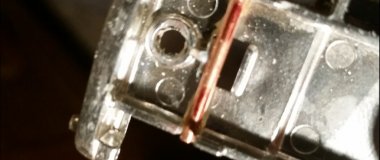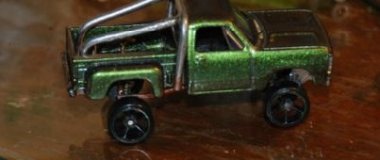The Axle Dilemma: A study in Fixed vs Loose axles
There are many decisions that go into modifying a diecast race car. Each one of those decisions has an impact on your car's performance. I am relatively new to 1:64 racing and still have many questions and a lot to learn. There are a number of resources online with countless opinions and ideas about what makes a diecast car fast. However, I have found that most of these opinions are exactly that...opinions. There are some great videos about the more established world of Pinewood Derby racing, which cite evidence for why certain adjustments make your car faster, but not all of the science is translatable to racing diecast cars. Primarily, what I like to call, "The axel dilemma."
It seems the most widely held opinion is that securing your axels (fixed down with JB weld) will make your car faster than leaving them loose. However, I have heard of a few experienced and successfull builders who prefer to run their cars with loose axles. So which is better? Why? I decided to do an experiment to see for myself.
I bought four current mainline Hot Wheels. Two Ford Focus RS and two 2017 Acura NSX. I labeled each set of cars 1 and 2 in order to tell them apart. Initially, right out of the package, I ran each set of cars down my modest track at home. 20 rounds, alternating lanes. The results were almost identical. Ford1: 11 wins, Ford2: 9 wins. Acura1: 9 wins, Acura2: 11 wins. The stock cars were very similar in speed and performance.
My test track starts with an Orange Track drag section, then turns into Crash Racers open track with a 180 and a loop. The inside lane is adventageous, so if the cars are equal, whichever one starts there usually wins. A car can, and does win from the outside lane if it is fast enough to overtake the inside car and beat it to the first corner.
After the initial test race, I drilled out all four cars. I fixed the axels of Ford2 and Acura1 with JB Weld. I left the axels of Ford1 and Acura2 loose. I purposely chose the Ford2 and Acura1 beacue their results were slightly worse than Ford1 and Acura2. I guessed that if fixed axels are better, the new advantage would be easliy seen in the "slower" cars. I left out the interiors of the fixed axels cars, but made no other modifications. Then I secured all four cars back together with screws.
I re-ran the cars, 20 rounds like before, alternating lanes. The results were staggering. Ford1: 19 wins, Ford 2: 1 win. Acura1: 6 wins, Acura2: 14 wins. There was a marked decrease in speed in the fixed axel cars. They consistently did not perform as well in the inital drag section of the track and did not beat the loose axel cars to the first corner.
Most surprising to me, was how much slower Ford2's fixed axel wheels seemed to spin. Initially, when I eyeball tested the cars, spinning each wheel and seeing how long it would turn, they all seemed pretty much the same. After securing Ford2's axels, the wheels turned for a noticably shorter time when I spun them with my finger.
This is a very small sample size, and by no means comprehensive, but I was surprised at the results. Has anyone else done experiments like this? What has been your experience?
I plan on doing more experiments like this. I still have lots of questions: What actually makes a "good wheel", is silent really better? (I've found some really fast, noisy cars) Does sanding wheels make a significant difference? (I hope not, because I find it really tedious)



Discussion
I'm thinking next time you need to glue down one fast car and one slow car. You glued down both slow cars and they both lost so there is no surprise there. Try one of each next time and see if it makes a difference in the faster car.
- You are right. I thought about the possibility that maybe fixing "bad axles/wheels" in place only magnifies their defects. If you secure a set of "good axels/wheels" does it do the same thing, but in a positive manner? hmm... — GrumpyCloud
I actually just did a little test of my own!... I'll finish editing the video and post it. The results were.... interesting lol.
I would also suggest doing your glue/no-glue testing on a simple straight drag strip as well, eliminating the randomness of the open section and turns. I think your findings are very interesting and incredibly helpful for anyone building a card...just something to consider if looking for a little more "science" in the data.
Very intresting, Thanks for sharing.
Here's a little test that I did that might interest you guys...https://youtu.be/VkEObclRgsQ
- That's an interesting jig you're using at about the three-minute mark. Could you tell us a little more about it? — SpyDude
- It's one that I made... it's the type that pulls the axles against the front and rear of the frame. The bearings are there to evenly tension the bands. It pretty much does what the red pill style jig does but because the bands can have more tension on one side or the other when you wrap it around, I figured individual bands would give more even tension and the bearing allow you to spin the rubber band to further even out the tension throughout the entire band. That's the theory behind it anyways lol. — revhobbies
Thank you to all who have contributed, especially Grumpy Cloud for sharing info in the article. Im a beginner & lean towards not securing axles, due to my belief, the likelihood that axle turning can only help gain in speed. I think however I'll try the experiment also, if I can get a few sets of identical cars out here in the sticks.... Thanks again all!
- If you do run some experiments, let us know how it turns out. Despite my recent findings, I found one of my latest builds to be slower than I wanted. I tinkered with it, and decided to anchor down the axels. After that, it ran much faster. So...who knows... — GrumpyCloud
- Will do... Looking forward to experimenting & sharing any info. Ya never know really how a car will turn out.... — G_ForceRacing
- In concur.... My latest thought... loose on "off road" (GTR), totally fixed on track racing. — G_ForceRacing
Good idea, enjoyed the read! You could go down the rabbit hole with weight and other modifications to see when fixed axels become better, if you had 500 hours to spare!!
Good work man!
Dalevis
Hi Everyone,
Old thread I know but there is sooo much great info here. I can add some info and share some info. For cars around 80 grams and 70 grams, I prefer to have mine loose. I have tried gluing my axels down 4 times with different cars and they came out slower each time and I've had no luck with it. Having it loose requires to spend more time polishing THE WHOLE AXEL. Not just the part of the axel where the wheels sit. The whole axel sitting loose will slightly spin so if you poslish the whole axel, you will reduce friction because the whole axel is polished making it easier for the whole axel to spin. Again this is my experience with the 70g - 80g category. I hope this is helpful for someone new.
- That is good info. It is interesting to hear all the different results people have. — GrumpyCloud
Well, this is a crazy way to sand down the wheels, but I seem to have pretty good results with it, just takes a bit of practice.
Before you pull the car apart, take the car and flip it upside down in your hand. You are going to be using your cloth polishing wheel on your dremel (or cheap replica thereof) and a small ROUND jeweler's file. Hold the Dremel and the file in your other hand so that the file is parallel to the body of the Dremel, with the tip of the file protruding just past the edge of the polishing wheel (DO NOT RUB THE FILE ON THE POLISHING WHEEL - VERY IMPORTANT!) Now, holding the car upside down, turn on the dremel on its LOWEST speed and press both the file and the polishing wheel against the wheel of the car, moving the file back and forth as necessary. The polishing wheel will spin the car wheel, while the file will smooth out the tread in a matter of seconds - a few passes back and forth across the tread while the wheel is spinning, and you're done.
I can easily do a car like this in under a minute to smooth out the wheels. Sounds crazy, but it works pretty well.
- I like it. Will try that this weekend! — dr_dodge
- I like it! Sanding wheels is so tedious...it is maybe my least enjoyable part of building a car. — GrumpyCloud
Here's what I was talking about earlier:
Hold the dremel and file together like this:
Then press them both to each wheel like this:

The polishing wheel spins the car wheel, while the file smooths down the tread.
I have found something similar with some of my customs, but I'm never sure if something leaked along the axle that I can't see, and it's that that caused the slow down or if it is specifically the fixing of the axle.
The one thing I do like about fixing the axle is that I find cars don't vary down the track as much as unfixed axles. In the Outlaws for instance, a car can be incredibly fast but if the axle is slightly moved then it bounces off the side walls too much or vary between each race. If they are fixed (presuming they are actually straight) then they seem to be more consistent overall.
- Fixed - and straight - is the key there! I agree 100%, running straight is more important than running fast. Now if only I could get them to run fast AND straight. — GrumpyCloud





Interesting....very interesting...
Thanks GrumpyCloud for sharing the results of your experiments!